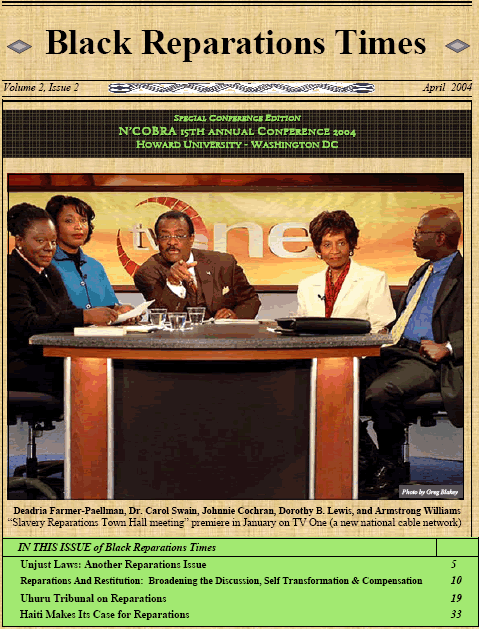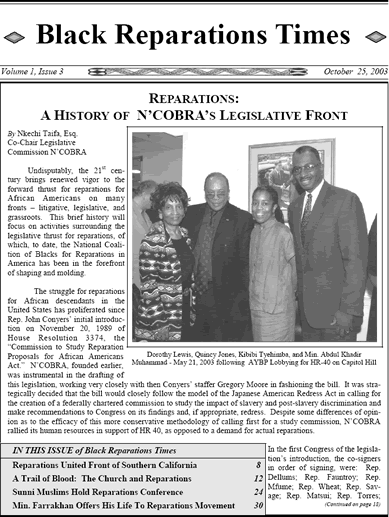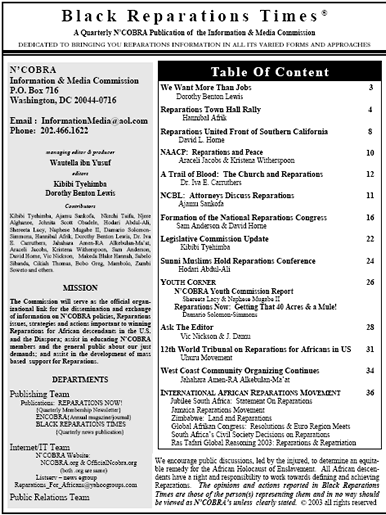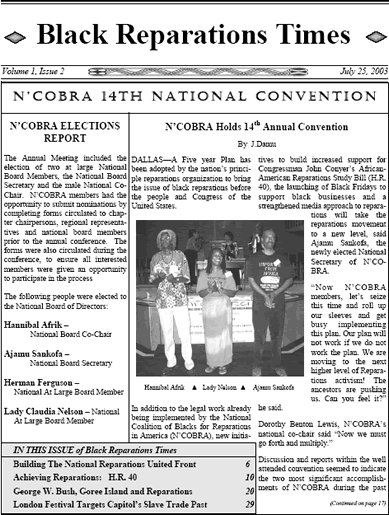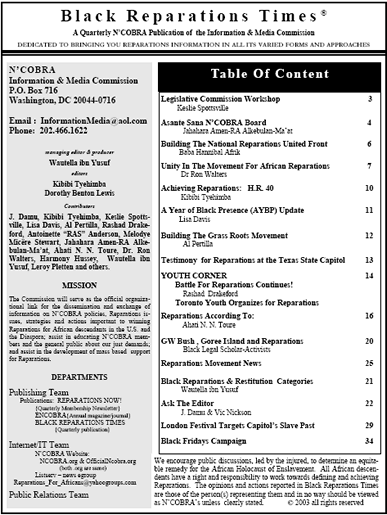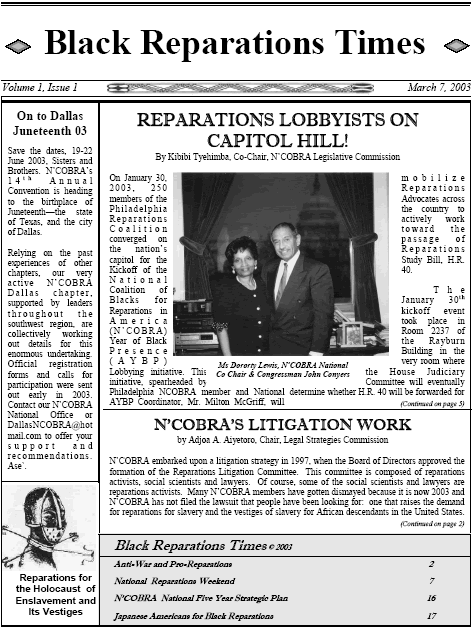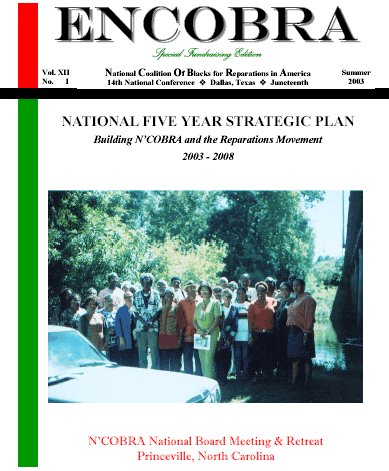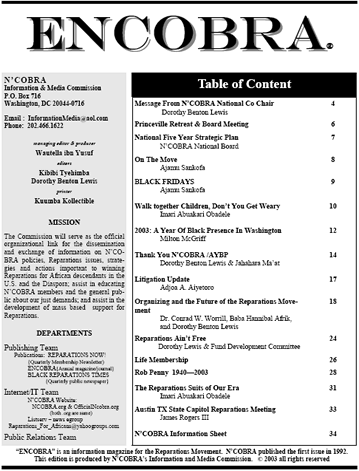|
Resources _________________________________________________________________________________________________
The Reparations Movement is like a train. The train left the station during slavery with the enslaved demanding some recompense for their, and their ancestors, forced free labor. That labor was in conditions which sought to strip them of their basic human dignity: their languages, their right to have and maintain families, their right to be free of State terror. In the 1860s it, the train, picked up those demanding passage of legislation to codify General Sherman's field Order 15 making 40 acres of federal land available to previously enslaved Africans. In the 1890s and early 1900s, the train stopped in Nashville, TN, and had to add new cars to to pick up Callie House and Rev. Isaiah Dickerson and the organization they led, The National Ex-Slave Mutual Relief Bounty and Pension Association. They sought pensions for previously enslaved Africans, and at one time the organization counted 600,000 members. This Ex-Slave Association was de-stabilized from within and without, and its ultimate demise came when the leadership was accused and convicted of mail fraud -- a charge that was borne of racism and a desire of the U.S. government to destroy the organization, although it was merely seeking some semblance of justice for the previously enslaved. The train, however, was not derailed by this obstacle. Its speed was slowed and its passengers and workers decreased. Yet it kept moving forward. As the train continued to chug along, doggedly heading for its final destination, it was joined by, among others, Queen Mother Moore, the Nation of Islam, the Republic of New Africa, the Lost Found Nation of Islam, the Black Reparations Commission, the National Conference of Black Lawyers, the New Afrikan People's Organization, ANRO, and others. Other groups and any number of individuals began to get on the train at various stations. The train was filled with people embracing various perspectives on reparations. Their ticket for the train ride was their determination to see reparations won and their willingness not simply to be passengers but, rather, to become the workers and fuel for the progress of the train. With the formation of N'COBRA in 1988, a consolidated set of cars was created. The cars served to embrace all the different views about reparations and to be open to passengers who here-to-before had been outside the Reparations Movement. These were "mainstream Americans," integrationists, leftists and, even, the politically conservative. N'COBRA charged itself with opening up the passenger/worker/supplier list to everyone -- encouraging, particularly, African-descended people from all backgrounds to see the importance of getting the train to its final destination with all deliberate speed. So, under the leadership of N'COBRA the train picked up more cars to accommodate additional passengers/worker/suppliers. N'COBRA brought on board organizations and people from Delta Sigma Theta, NAACP, the National Bar Association, Sigma Gamma Rho, and others. In 1988 it joined forces with Congressman John Conyers from Michigan, reviewing his proposed legislation for a Reparations Study bill, and joined in support of this legislation, formally introduced for the first time in 1989. Through its various chapters, N'COBRA got state and local legislatures to pass resolutions to support Conyers' bill, submitted each Congressional session in the House of Representatives Judiciary Committee, usually designated H.R. 40. The varied resolutions usually cited the work of N'COBRA. The coalition developed legislative, litigative, direct action, and economic development strategies to fuel the train and increase the speed with which it was moving to its destination -- reparations. With the increase in reparations activity, the train went from one that traveled the back rails to one that was in the main thoroughfares. The Florida legislature voted to give reparations to the victims of state-sanctioned race violence in Rosewood, which occurred in 1923. A reparations commission was formed by the legislature in Oklahoma to look at the destruction of what was popularly known as "Black Wall Street" but ultimately failed to vote any reparations. The film Rosewood was released. Another film, Amistad, followed on its heels. Then the year 2000 hit with a bang. Randall Robinson's book, The Debt, was released in January. Deadria Farmer Paellman's research, showing the linkage of Aetna Insurance Company to slavery was reported in the mainstream press. The train is moving fast now, yet at every stop it is picking up more and more passengers. Many who have been on the train for a while start feeling crowded. Some who just got on the train want to ignore those who have been traveling for a long time. There is a certain excitement, a buzz going through the train that has a feel of anticipation as well as possessiveness. The train is moving and everyone wants to own it -- wants to claim that it is their fuel, their ticket, their effort that is responsible for the train's momentum. The crowds outside the train clamor for a look as the train is speeding down the track. Many of them, prodigies of the tinsel-town mentality that is uniquely Western, clamor to see those with mainstream notoriety. They tend to ignore the less famous, hard-working masses and leaders of the masses and seek to be in the shadow of those who they feel have some status. There is disruption on the train. A low rumbling is going on. Yet the train keeps moving. It has picked up some speed on its own. The rumbling is not slowing it down, yet rocking it ever so slightly. Then, lo and behold, the train picks up additional international passengers. The preparatory process for the World Conference Against Racism includes organizations that embrace reparations: December 12th Movement, Women's International League for Peace and Freedom, Race Relations Institute, ALIANZA and others. And the train becomes an international carrier, linking the reparations movement in the United States to reparations movements throughout the Americas, in Europe and in Africa. The Hills and Valleys Along the Way to Victory Clearly, the history of this Reparations Movement reveals one major hill and valley as government actions to destabilize and destroy the momentum to reparations. The imprisonment of our leaders, resulting in significant destabilization of the organizations which they led, is an age-old tactic and not one specifically directed at reparation work. We saw it in COINTELPRO, with Black Liberation organizations such as the Black Panthers. The diversity in the movement is another hill and valley. It is more comfortable working with people and organizations that agree on basic strategies to win reparations and the forms it should take. It is harder to maintain the momentum of the train when there is diversity in ideas about the route to reparations and the form of reparations. As the diversity increases, N'COBRA must continue to be a stabilizing force; the all-embracing coalition that allows for and in fact creates opportunities for open dialogue for the purpose of having an inclusive picture of reparations and a route that allows for the inclusion of the most people. Competition for strategies is another hill and valley. In order to get to the final destination we will need to use many different mechanisms and strategies. There is no one strategy that will win the day. The train needs porters, engineers, cooks, fuel, furniture and passengers to name only some things. The train's fuel may be wood at one time, coal at another time, and raw determination at another. Similarly, we have to respect and support each of the primary strategies of N'COBRA including legislative lobbying, direct action, economic development, public education, and litigation. The train will get to the final destination not with one, but all efforts. Each of the strategies works together to pull and push the train into the final station. Each of the strategies can be seen as supportive of the entire movement. Finally, we have to put our money where our mouth is. The adage rings true: "Freedom ain't Free." We have to raise the money necessary to keep the train moving. We have to dig deep into our pockets for the price of the ticket, the price of the meals, the fuel, the supplies and the furnishings necessary to keep the train running, to add new cars and to get to our final destination - the obtaining of reparations. The Victory is There - We Must Claim It When you are planning a vacation or even a big business trip you often visualize being there before you get there. You can see yourself having fun with friends or relatives or, in the case of business, participating in the meeting or obtaining some needed service. If you watch your visualization, you see that what you expected is often obtained. The same is true for reparations. Let's hold the vision of obtaining reparations. Visualize us sitting around the table negotiating the terms of reparations. Picture a successful outcome in that negotiation -- what do you want for reparations? Stay with that picture as we traverse the land on this train picking up passengers, workers and fuel along the way. Claim the victory and then all the hills and valleys will be just that, hills and valleys that will be traversed. Claim the victory and no power can stop us. Claim the victory now and see it unfold. I can see the light at the end of the tunnel. I can see the vindication of our ancestors through receipt of reparations. I can see the striking down of laws that maintain vestiges of slavery. I can see the schoolbooks depicting our history with respect and new found accuracy. I can see our children learning about the contributions of their ancestors from the beginning of time until today. I can see the poverty stricken communities being infused with resources to provide adequate housing and other life-sustaining and enhancing facilities. I see it. Victory is ours! Back To The Top Reparations Coordinating Committee Files Tulsa Reparations Case N'COBRA is pleased to be a part of historic reparations litigation for the acts of terror that destroyed the Greenwood district of Tulsa, Oklahoma (Black Wall Street), murdered and brutalized its residents and forcibly separated them from their homes. This act of terror has continuing consequences to this very day. Download First Ammendment Case (PDF) __________________________________________________________________________________________________ Dr. Ronald Walters
_________________________________________________________________________________________________ CORPORATE RESTITUTION FOR SLAVERY: ________________________________________________________________________________________________ UNITED FRONT REQUIRED TO WIN REPARATIONS _________________________________________________________________________________________________
"Two groups of plaintiffs, Jewel Cato, Joyce Cato, Howard Cato and Edward Cato; and Leerma Patterson, Charles Patterson, and Bobbie Trice Johnson (collectively "Cato"), filed nearly identical complaints in forma pauperis against the United States for damages due to the enslavement of African Americans
and subsequent discrimination against them, for an acknowledgment of discrimination, and for an apology. 1 The district court in both cases dismissed the complaints prior to service pursuant to 28 U.S.C. S 1915(d)" ____________________________________________________________________________________ A declaration of the first Abuja Pan-African Conference
on Reparations For African Enslavement, Colonization And ____________________________________________________________________________________________ An Act establishing the New Jersey African-American Reconciliation Study Commission and making an appropriation. Be It Enacted by the Senate and General Assembly of the State of New Jersey: 1. The Legislature finds and declares that: a. The institution of slavery in America dates back to the beginning of the colonial period. Slavery was constitutionally and statutorily sanctioned by the United States government from 1789 through 1865. During that period, millions of persons of African origin were brought to this country against their will, deprived of their liberty, their property, their children and often their lives. Slavery assaulted the dignity and humanity of the persons who were enslaved, treating them as property and forced them to work under brutal physical and psychological conditions. ________________________________________________________________________________________________ UNITED STATES DISTRICT COURT For The EASTERN DISTRICT OF NEW YORK Download Farmer-Paellmann Case(PDF) _________________________________________________________________________________________ Advanced Policy Analysis Federal Reparations Policy: A Cost Benefit Framework By Angie Rogers In many respects, this analysis is presented in the same spirit in which Richard America presented Paying the Social Debt and The Wealth of Races. Amidst a dominant conversation that concerns itself with the legal, moral, and ethical justifications for reparations, a baseline assumption is often made that an empirical analysis has no place in these conversations. Analyses like America’s and the one offered here contend that we can talk about the law, we can talk about history, and we can talk about ethics, but we can also talk about dollars and cents and measuring up. _____________________________________________________________________________________
2003: A YEAR OF BLACK PRESENCE IN WASHINGTON
On January 30, 2003, the National Coalition of Blacks for Reparations in America (N'COBRA) brings Robinson's concept to life. Four N'COBRA chapters in the Northeast Region - Philadelphia, D.C. Metro, Baltimore, New York - will pick a day in each of the first four months and take 1,000 African Americans to "walk the halls of Congress" on that day. We need the entire national body of N'COBRA and its supporters to create A Year of Black Presence that Congress cannot ignore. In October 2001, Philadelphia N'COBRA created a pilot project of A Year of Black Presence. We asked several local organizations to join us in a coalition that would focus on just one aspect of the reparations issue: HR 40. Philadelphia's goal for January 30, 2003, is filling 20 buses with 49 people each, a total of 980 people. We are charging $20 for tickets, with $15 of each ticket going toward the cost of the bus. On a full bus, the remaining $245 will be used either for a "unity item" or for food. A "unity item" is something that will identify the AYBP participants walking the halls of Congress easily: a cap, T-shirt, etc. Although we are assigning specific AYBP dates to selected Northeast Region cities, this has to do with their proximity to Washington. If any other chapters or individuals can make the trip, we will provide all the information about how we are organizing this effort. Other chapters can either pick a day of their own or come down on a day already being organized. There's no reason we can't have more than 1,000 people or more than one day a month. We do want to coordinate our plans through the N'COBRA Phila, AYBP: 215.604.3658 ___________________________________________________________________________________ Milton McGriff,National Coordinator “REMARKS” made at Press Conference on Capitol Hill for kick off of the National Coalition of Blacks for Reparations in America (N’COBRA) Year of Black Presence (AYBP) Lobbying initiative January 30, 2003 ________________________________________________________________________________________ STATE AND LOCAL MUNICIPALITIES SUPPORTING H.R. 40
__________________________________________________________________________________________ ORGANIZATIONS SUPPORTING H.R. 40 *
________________________________________________________________________________ The Greenwood Plan: Reparations for the Greenwood Holocaust By Damario Solomon Simmons This paper will accomplish the following: 1) prove that describing the Greenwood massacre, as a “race riot” is erroneous; because the White citizens of Tulsa plotted to destroy the Black community of Greenwood, and through unprecedented urban warfare, White Tulsans, accomplished their mission. As a result, it is more accurate to refer to this incident, not as the “Tulsa Race Riot” but as the “Greenwood Holocaust”, because thousands of guilty Whites intentionally executed an unprecedented war on the Black citizens of Greenwood that led to the total destruction of the community; 2) to present a comprehensive reparations plan to compensate the victims and their descendents for the destruction to Greenwood and its Black citizens; and 3) to present a strategy for adopting this reparations plan for the victims of this horrible crime. ___________________________________________________________________________________ Reparations and A New Global Order: A Comparative Overview by Professor Chinweizu A paper read at the second Plenary Session
of the First Pan-African Conference on _________________________________________________________________________________ "THE ETHICS OF REPARATIONS: ENGAGING THE HOLOCAUST OF ENSLAVEMENT" MAULANA KARENGA The struggle for reparations for the Holocaust of Enslavement of African people is clearly one of the most important struggles being waged in the world today. For it is about fundamental issues of human freedom, human justice and the value we place on human life in the past as well as in the present and future. It is a struggle which, of necessity, contributes to our regaining and refreshing our historical memory as a people remembering and raising up the rightful claims of our ancestors to lives of dignity and decency and to our reaffirming and securing the rights and capacity of their descendants to live free, full and meaningful lives in our times. Download The Ethics of Reparations (PDF) ___________________________________________________________________________________ Kimani Nehusi
For the African people a full and correct understanding of the term ‘reparation’ demands that this notion be applied to the specific historical experience and the related contemporary condition of the great majority of our people across this planet. It will then be seen clearly that the meaning of this term transcends repayment for past and continuing wrong, to embrace self-rehabilitation through education, organisation and mobilisation. Download The Meaning of Reparation (PDF) _________________________________________________________________________________
CAN A REPARATIONS PACKAGE BE A BILL OF ATTAINDER? By Mathew Manweller Everybody, it seems, is in the mood to apologize. The U.S. Congress has considered apologizing to African Americans for the country’s history of slavery. During his term in office, President Clinton offered multiple apologies: to the Rwandan people for lack of U.S. action during Rwanda’s ethnic civil war; to native Hawaiians for nineteenth-century imperialism; to survivors of the infamous Tuskegee experiments (Brooks 1999). The Catholic Church recently apologized for the Inquisition and the Holocaust (Bohlen 1997). The Japanese government, under pressure, apologized for abusing Korean “comfort women” during World War II. In one of the more unusual cases, Aetna, an insurance company, apologized for selling policies to slave owners in the 1850s. Some political and social activists have gone a step further and pushed Aetna, as well as governmental institutions, to pay reparations for their acts of more than a century ago. The apparent “contrition chic” that has descended over the twenty-first century has led Roy Brooks to label this century the “Age of Apology” (1999, 3). Download Bill Of Attainer (PDF) _____________________________________________________________________________________ In response to the growing momentum of the Reparations movement, the Information and Media Commission is committed to disseminating timely information on issues related to our struggle for Reparations. Our new publication, "BLACK REPARATIONS TIMES" © 2003 is a step up from the N’COBRA membership newsletter "REPARATIONS NOW!", and will report news and information not only about N’COBRA’s work, but also the efforts of other Reparations advocates, nationally and internationally. Please let us know what you think of our first edition of "BLACK REPARATIONS TIMES". Your suggestions are always welcome. You can also help out by: 1) providing items for possible publication such as articles, photos, etc; 2) volunteering professional skills (graphic arts, managing subscriptions & distribution, fundraising, etc.); 3) donating generously to this project, and 4) identifying potential sponsors. ______________________________________________________________________________________
Download Black Reparations Times (Apr 2004)The Complete Publication (PDF)
____________________________________________________________________________________
(BLACK REPARATIONS TIMES October 2003)
_________________________________________________________________________________________________
(BLACK REPARATIONS TIMES July 2003)
__________________________________________________________________________________________________
(BLACK REPARATIONS TIMES March 2003) Download Black Reparations Times (March 2003) The Complete Publication (PDF) ___________________________________________________________ Download ENCOBRA MAGAZINE (PDF)
|
